pbo ,经典外文解说http://www.songho.ca/opengl/gl_pbo.html#overview
来源:互联网 发布:淘宝卖家团购怎么弄 编辑:程序博客网 时间:2024/05/17 10:07
OpenGL Pixel Buffer Object (PBO)
Related Topics: Vertex Buffer Object (VBO), Frame Buffer Object (FBO)
Download: pboUnpack.zip, pboPack.zip
- Overview
- Creating PBO
- Mapping PBO
- Example: Streaming Texture Uploads with PBO
- Example: Asynchronous Readback with PBO
Overview
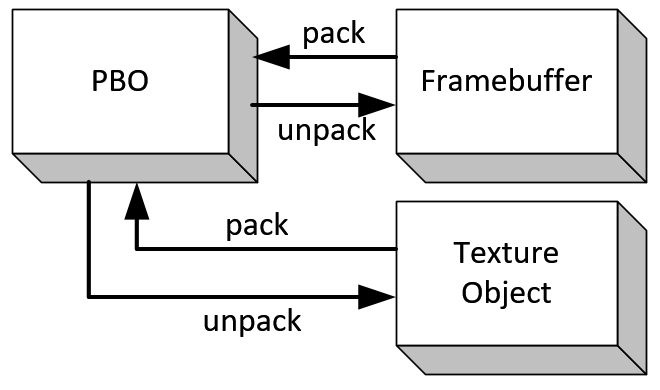
OpenGL PBO
OpenGL ARB_pixel_buffer_object extension is very close to ARB_vertex_buffer_object. It simply expands ARB_vertex_buffer_object extension in order to store not only vertex data but also pixel data into the buffer objects. This buffer object storing pixel data is called Pixel Buffer Object (PBO). ARB_pixel_buffer_object extension borrows all VBO framework and APIs, plus, adds 2 additional "target" tokens. These tokens assist the PBO memory manger (OpenGL driver) to determine the best location of the buffer object; system memory, AGP (shared memory) or video memory. Also, the target tokens clearly specify the bound PBO will be used in one of 2 different operations; GL_PIXEL_PACK_BUFFER_ARB to transfer pixel data to a PBO, or GL_PIXEL_UNPACK_BUFFER_ARB to transfer pixel data from PBO.
For example, glReadPixels() and glGetTexImage() are "pack" pixel operations, and glDrawPixels(), glTexImage2D() and glTexSubImage2D() are"unpack" operations. When a PBO is bound with GL_PIXEL_PACK_BUFFER_ARB token, glReadPixels() reads pixel data from a OpenGL framebuffer and write (pack) the data into the PBO. When a PBO is bound with GL_PIXEL_UNPACK_BUFFER_ARB token, glDrawPixels() reads (unpack) pixel data from the PBO and copy them to OpenGL framebuffer.
The main advantage of PBO are fast pixel data transfer to and from a graphics card through DMA (Direct Memory Access) without involing CPU cycles. And, the other advantage of PBO is asynchronous DMA transfer. Let's compare a conventional texture transfer method with using a Pixel Buffer Object. The left side of the following diagram is a conventional way to load texture data from an image source (image file or video stream). The source is first loaded into system memory, and then, copied from system memory to an OpenGL texture object with glTexImage2D(). These 2 transfer processes (load and copy) are all performed by CPU.
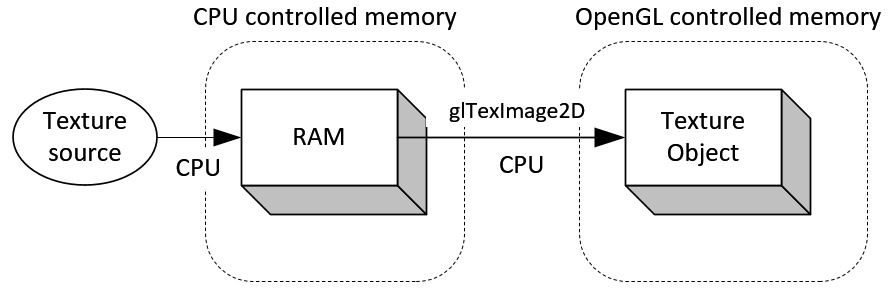
Texture loading without PBO
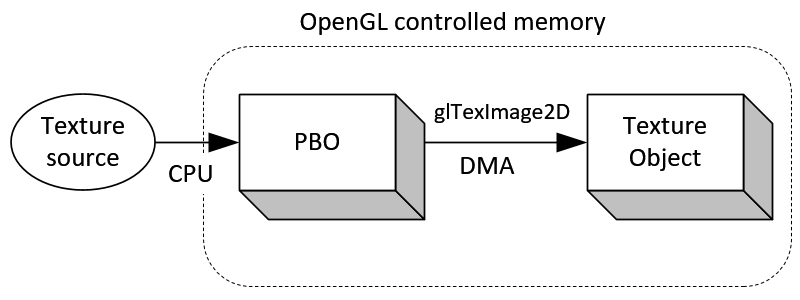
Texture loading with PBO
On the contrary in the right side diagram, the image source can be directly loaded into a PBO, which is controlled by OpenGL. CPU still involves to load the source to the PBO, but, not for transferring the pixel data from a PBO to a texture object. Instead, GPU (OpenGL driver) manages copying data from a PBO to a texture object. This means OpenGL performs a DMA transfer operation without wasting CPU cycles. Further, OpenGL can schedule an asynchronous DMA transfer for later execution. Therefore, glTexImage2D() returns immediately, and CPU can perform something else without waiting the pixel transfer is done.
There are 2 major PBO approaches to improve the performance of the pixel data transfer:streaming texture update andasynchronous read-back from the framebuffer.
Creating PBO
As mentioned earlier, Pixel Buffer Object borrows all APIs from Vertex Buffer Object. The only difference is there are 2 additional tokens for PBOs:GL_PIXEL_PACK_BUFFER_ARB and GL_PIXEL_UNPACK_BUFFER_ARB. GL_PIXEL_PACK_BUFFER_ARB is for transferring pixel data from OpenGL to your application, and GL_PIXEL_UNPACK_BUFFER_ARB means transferring pixel data from an application to OpenGL. OpenGL refers to these tokens to determine the best memory space of a PBO, for example, a video memory for uploading (unpack) textures, or system memory for reading (pack) framebuffer. However, these target tokens are solely hint. OpenGL driver decides the appropriate location for you.
Creating a PBO requires 3 steps;
- Generate a new buffer object with glGenBuffersARB().
- Bind the buffer object with glBindBufferARB().
- Copy pixel data to the buffer object with glBufferDataARB().
If you specify a NULL pointer to the source array in glBufferDataARB(), then PBO allocates only a memory space with the given data size. The last parameter of glBufferDataARB() is another performance hint for PBO to provide how the buffer object will be used. GL_STREAM_DRAW_ARB is for streaming texture upload and GL_STREAM_READ_ARB is for asynchronous framebuffer read-back.
Please check VBO for more details.
Mapping PBO
PBO provides a memory mapping mechanism to map the OpenGL controlled buffer object to the client's address space. So, the client can modify a portion of the buffer object or the entire buffer by usingglMapBufferARB() and glUnmapBufferARB().
void* glMapBufferARB(GLenum target, GLenum access)GLboolean glUnmapBufferARB(GLenum target)glMapBufferARB() returns the pointer to the buffer object if success. Otherwise it returns NULL. Thetarget parameter is GL_PIXEL_PACK_BUFFER_ARB or GL_PIXEL_UNPACK_BUFFER_ARB. The second parameter,access specifies what to do with the mapped buffer; read data from the PBO (GL_READ_ONLY_ARB), write data to the PBO (GL_WRITE_ONLY_ARB), or both (GL_READ_WRITE_ARB).
Note that if GPU is still working with the buffer object, glMapBufferARB() will not return until GPU finishes its job with the corresponding buffer object. To avoid this stall(wait), call glBufferDataARB() with NULL pointer right before glMapBufferARB(). Then, OpenGL will discard the old buffer, and allocate new memory space for the buffer object.
The buffer object must be unmapped with glUnmapBufferARB() after use of the PBO. glUnmapBufferARB() returns GL_TRUE if success. Otherwise, it returns GL_FALSE.
Example: Streaming Texture Uploads
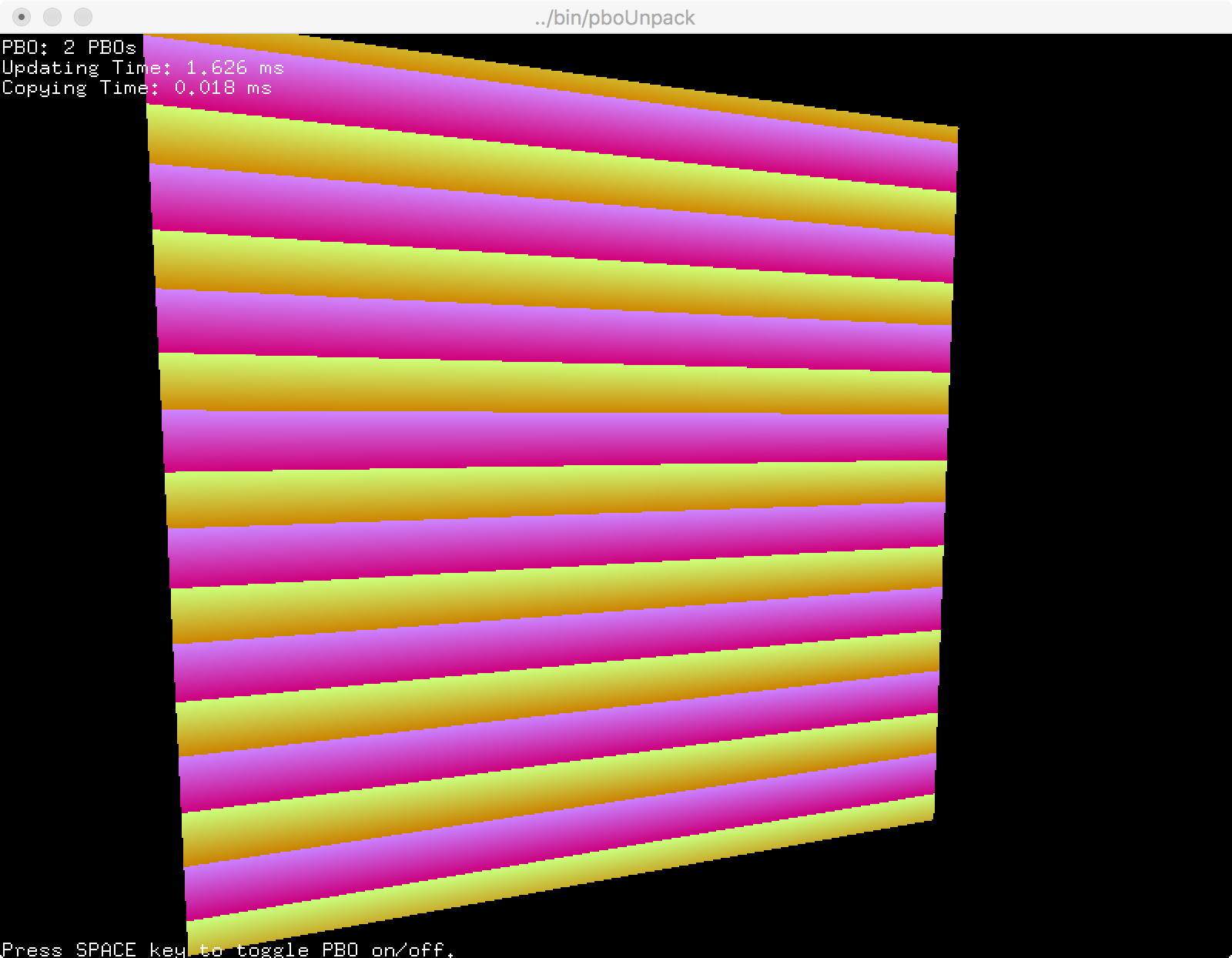
Download the source and binary: pboUnpack.zip.
This demo application uploads (unpack) streaming textures to an OpenGL texture object using PBO. You can switch to the different transfer modes (single PBO, double PBOs and without PBO) by pressing the space key, and compare the performance differences.
The texture sources are written directly on the mapped pixel buffer every frame in the PBO modes. Then, these data are transferred from the PBO to a texture object using glTexSubImage2D(). By using PBO, OpenGL can perform asynchronous DMA transfer between a PBO and a texture object. It significantly increases the texture upload performance. If asynchronous DMA transfer is supported, glTexSubImage2D() should return immediately, and CPU can process other jobs without waiting the actual texture copy.
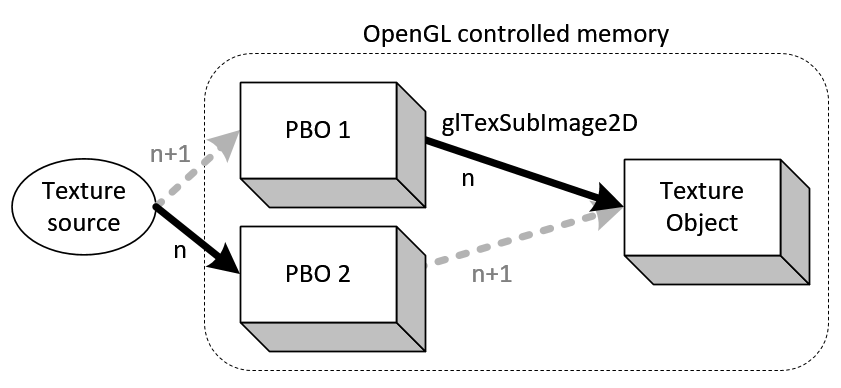
Streaming texture uploads with 2 PBOs
To maximize the streaming transfer performance, you may use multiple pixel buffer objects. The diagram shows that 2 PBOs are used simultaneously; glTexSubImage2D() copies the pixel data from a PBO while the texture source is being written to the other PBO.
For nth frame, PBO 1 is used for glTexSubImage2D() and PBO 2 is used to get new texture source. Forn+1th frame, 2 pixel buffers are switching the roles and continue to update the texture. Because of asynchronous DMA transfer, the update and copy processes can be performed simultaneously. CPU updates the texture source to a PBO while GPU copies texture from the other PBO.
// "index" is used to copy pixels from a PBO to a texture object// "nextIndex" is used to update pixels in the other PBOindex = (index + 1) % 2;nextIndex = (index + 1) % 2;// bind the texture and PBOglBindTexture(GL_TEXTURE_2D, textureId);glBindBufferARB(GL_PIXEL_UNPACK_BUFFER_ARB, pboIds[index]);// copy pixels from PBO to texture object// Use offset instead of ponter.glTexSubImage2D(GL_TEXTURE_2D, 0, 0, 0, WIDTH, HEIGHT, GL_BGRA, GL_UNSIGNED_BYTE, 0);// bind PBO to update texture sourceglBindBufferARB(GL_PIXEL_UNPACK_BUFFER_ARB, pboIds[nextIndex]);// Note that glMapBufferARB() causes sync issue.// If GPU is working with this buffer, glMapBufferARB() will wait(stall)// until GPU to finish its job. To avoid waiting (idle), you can call// first glBufferDataARB() with NULL pointer before glMapBufferARB().// If you do that, the previous data in PBO will be discarded and// glMapBufferARB() returns a new allocated pointer immediately// even if GPU is still working with the previous data.glBufferDataARB(GL_PIXEL_UNPACK_BUFFER_ARB, DATA_SIZE, 0, GL_STREAM_DRAW_ARB);// map the buffer object into client's memoryGLubyte* ptr = (GLubyte*)glMapBufferARB(GL_PIXEL_UNPACK_BUFFER_ARB, GL_WRITE_ONLY_ARB);if(ptr){ // update data directly on the mapped buffer updatePixels(ptr, DATA_SIZE); glUnmapBufferARB(GL_PIXEL_UNPACK_BUFFER_ARB); // release the mapped buffer}// it is good idea to release PBOs with ID 0 after use.// Once bound with 0, all pixel operations are back to normal ways.glBindBufferARB(GL_PIXEL_UNPACK_BUFFER_ARB, 0);Example: Asynchronous Read-back
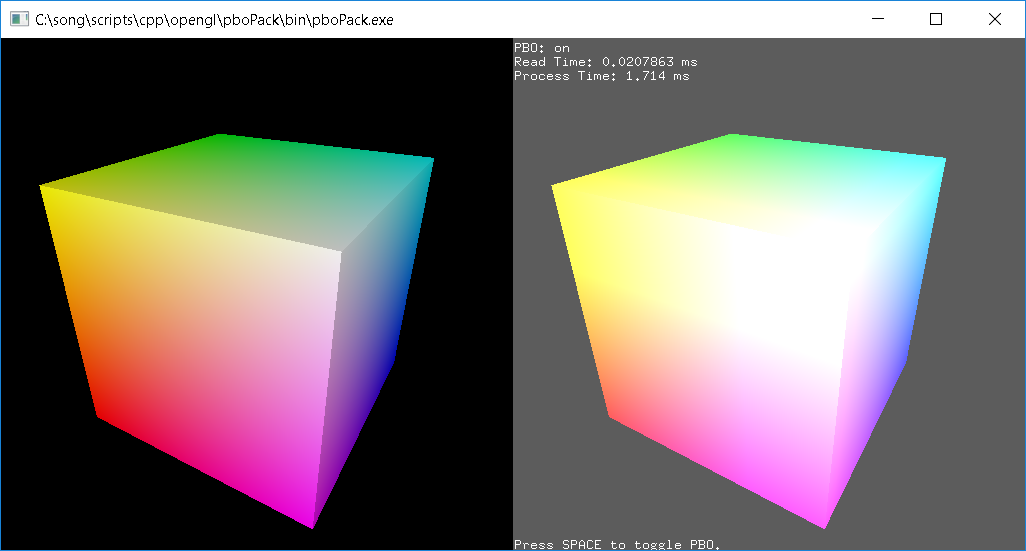
Download the source and binary: pboPack.zip.
This demo application reads (pack) the pixel data from the framebuffer (left-side) to a PBO, then, draws it back to the right side of the window after modifying the brightness of the image. You can toggle PBO on/off by pressing the space key, and measure the performance of glReadPixels().
Conventional glReadPixels() blocks the pipeline and waits until all pixel data are transferred. Then, it returns control to the application. On the contrary, glReadPixels() with PBO can schedule asynchronous DMA transfer and returns immediately without stall. Therefore, the application (CPU) can execute other process right away, while transferring data with DMA by OpenGL (GPU).
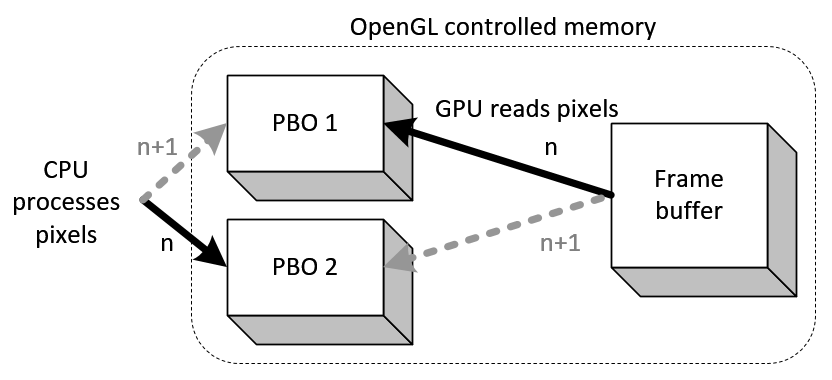
Asynchronous glReadPixels() with 2 PBOs
This demo uses 2 pixel buffers. At frame n, the application reads the pixel data from OpenGL framebuffer toPBO 1 using glReadPixels(), and processes the pixel data in PBO 2. These read and process can be performed simultaneously, because glReadPixels() toPBO 1 returns immediately and CPU starts to process data in PBO 2 without delay. And, we alternate betweenPBO 1 and PBO 2 on every frame.
// "index" is used to read pixels from framebuffer to a PBO// "nextIndex" is used to update pixels in the other PBOindex = (index + 1) % 2;nextIndex = (index + 1) % 2;// set the target framebuffer to readglReadBuffer(GL_FRONT);// read pixels from framebuffer to PBO// glReadPixels() should return immediately.glBindBufferARB(GL_PIXEL_PACK_BUFFER_ARB, pboIds[index]);glReadPixels(0, 0, WIDTH, HEIGHT, GL_BGRA, GL_UNSIGNED_BYTE, 0);// map the PBO to process its data by CPUglBindBufferARB(GL_PIXEL_PACK_BUFFER_ARB, pboIds[nextIndex]);GLubyte* ptr = (GLubyte*)glMapBufferARB(GL_PIXEL_PACK_BUFFER_ARB, GL_READ_ONLY_ARB);if(ptr){ processPixels(ptr, ...); glUnmapBufferARB(GL_PIXEL_PACK_BUFFER_ARB);}// back to conventional pixel operationglBindBufferARB(GL_PIXEL_PACK_BUFFER_ARB, 0);- pbo ,经典外文解说http://www.songho.ca/opengl/gl_pbo.html#overview
- OpenGL Projection Matrix :http://www.songho.ca/opengl/gl_projectionmatrix.html
- vbo http://www.songho.ca/opengl/gl_vbo.html
- OpenGL---PBO
- Emacs快捷键 转自:http://www.engr.uvic.ca/~dastone/emacs-keys.html
- http://www.sciencedirect.com/ 外文文献免费全文下载方法
- http://www.bluecoat.com.cn/resources/overview
- 使用OpenGL开发一个指南针 (http://www.hiapk.com/thread-513153-1-1.html)
- OpenGL Pixel Buffer Object (PBO)
- OPENGL VBO,FBO和PBO
- OpenGL Pixel Buffer Object (PBO)
- OpenGL VBO, PBO与FBO
- OpenGL像素缓冲对象(PBO)
- OpenGL VBO, PBO与FBO
- OpenGL Pixel Buffer Object (PBO)
- 使用Opengl PBO上传下载数据
- OpenGL VBO, PBO与FBO
- OpenGL Overview
- android 自动化测试工具(Ranorex)
- mplayer也可播放YUV数据
- CentOS 6.3 下用ntfs-3g挂载Widows NTFS分区
- C++重载箭头操作符
- 局部最小点
- pbo ,经典外文解说http://www.songho.ca/opengl/gl_pbo.html#overview
- Android近场通信---NFC基础(三)
- C#扩展..
- IPV6概述(1)
- HDU3448 Bag Problem 01思想+搜索
- 工作了
- struts 页面取值
- iOS5 Library NSString - 创建与初始化strings
- 排序算法之归并排序法


